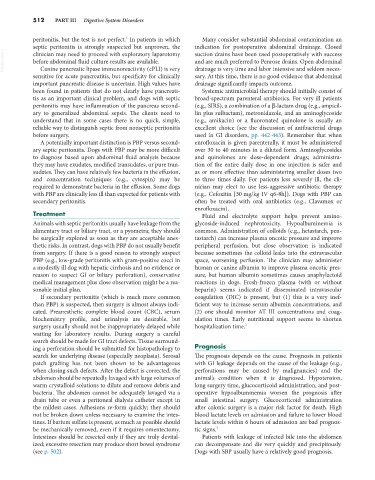Page 540 - Small Animal Internal Medicine, 6th Edition
P. 540
512 PART III Digestive System Disorders
1
peritonitis, but the test is not perfect. In patients in which Many consider substantial abdominal contamination an
septic peritonitis is strongly suspected but unproven, the indication for postoperative abdominal drainage. Closed
VetBooks.ir clinician may need to proceed with exploratory laparotomy suction drains have been used postoperatively with success
and are much preferred to Penrose drains. Open abdominal
before abdominal fluid culture results are available.
Canine pancreatic lipase immunoreactivity (cPLI) is very
sary. At this time, there is no good evidence that abdominal
sensitive for acute pancreatitis, but specificity for clinically drainage is very time and labor intensive and seldom neces-
important pancreatic disease is uncertain. High values have drainage significantly impacts outcome.
been found in patients that do not clearly have pancreati- Systemic antimicrobial therapy should initially consist of
tis as an important clinical problem, and dogs with septic broad-spectrum parenteral antibiotics. For very ill patients
peritonitis may have inflammation of the pancreas second- (e.g., SIRS), a combination of a β-lactam drug (e.g., ampicil-
ary to generalized abdominal sepsis. The clients need to lin plus sulbactam), metronidazole, and an aminoglycoside
understand that in some cases there is no quick, simple, (e.g., amikacin) or a fluoronated quinolone is usually an
reliable way to distinguish septic from nonseptic peritonitis excellent choice (see the discussion of antibacterial drugs
before surgery. used in GI disorders, pp. 442-443). Remember that when
A potentially important distinction is PBP versus second- enrofloxacin is given parenterally, it must be administered
ary septic peritonitis. Dogs with PBP may be more difficult over 30 to 40 minutes in a diluted form. Aminoglycosides
to diagnose based upon abdominal fluid analysis because and quinolones are dose-dependent drugs; administra-
they may have exudates, modified transudates, or pure tran- tion of the entire daily dose in one injection is safer and
sudates. They can have relatively few bacteria in the effusion, as or more effective than administering smaller doses two
and concentration techniques (e.g., cytospin) may be to three times daily. For patients less severely ill, the cli-
required to demonstrate bacteria in the effusion. Some dogs nician may elect to use less-aggressive antibiotic therapy
with PBP are clinically less ill than expected for patients with (e.g., Cefoxitin [30 mg/kg IV q6-8h]). Dogs with PBP can
secondary peritonitis. often be treated with oral antibiotics (e.g., Clavamox or
enrofloxacin).
Treatment Fluid and electrolyte support helps prevent amino-
Animals with septic peritonitis usually have leakage from the glycoside-induced nephrotoxicity. Hypoalbuminemia is
alimentary tract or biliary tract, or a pyometra; they should common. Administration of colloids (e.g., hetastarch, pen-
be surgically explored as soon as they are acceptable anes- tastarch) can increase plasma oncotic pressure and improve
thetic risks. In contrast, dogs with PBP do not usually benefit peripheral perfusion, but close observation is indicated
from surgery. If there is a good reason to strongly suspect because sometimes the colloid leaks into the extravascular
PBP (e.g., low-grade peritonitis with gram-positive cocci in space, worsening perfusion. The clinician may administer
a modestly ill dog with hepatic cirrhosis and no evidence or human or canine albumin to improve plasma oncotic pres-
reason to suspect GI or biliary perforation), conservative sure, but human albumin sometimes causes anaphylactoid
medical management plus close observation might be a rea- reactions in dogs. Fresh-frozen plasma (with or without
sonable initial plan. heparin) seems indicated if disseminated intravascular
If secondary peritonitis (which is much more common coagulation (DIC) is present, but (1) this is a very inef-
than PBP) is suspected, then surgery is almost always indi- ficient way to increase serum albumin concentrations, and
cated. Preanesthetic complete blood count (CBC), serum (2) one should monitor AT III concentrations and coag-
biochemistry profile, and urinalysis are desirable, but ulation times. Early nutritional support seems to shorten
surgery usually should not be inappropriately delayed while hospitalization time. 2
waiting for laboratory results. During surgery a careful
search should be made for GI tract defects. Tissue surround-
ing a perforation should be submitted for histopathology to Prognosis
search for underlying disease (especially neoplasia). Serosal The prognosis depends on the cause. Prognosis in patients
patch grafting has not been shown to be advantageous with GI leakage depends on the cause of the leakage (e.g.,
when closing such defects. After the defect is corrected, the perforations may be caused by malignancies) and the
abdomen should be repeatedly lavaged with large volumes of animal’s condition when it is diagnosed. Hypotension,
warm crystalloid solutions to dilute and remove debris and long surgery time, glucocorticoid administration, and post-
bacteria. The abdomen cannot be adequately lavaged via a operative hypoalbuminemia worsen the prognosis after
drain tube or even a peritoneal dialysis catheter except in small intestinal surgery. Glucocorticoid administration
the mildest cases. Adhesions re-form quickly; they should after colonic surgery is a major risk factor for death. High
not be broken down unless necessary to examine the intes- blood lactate levels on admission and failure to lower blood
tines. If barium sulfate is present, as much as possible should lactate levels within 6 hours of admission are bad prognos-
be mechanically removed, even if it requires omentectomy. tic signs. 3
Intestines should be resected only if they are truly devital- Patients with leakage of infected bile into the abdomen
ized; excessive resection may produce short bowel syndrome can decompensate and die very quickly and precipitously.
(see p. 502). Dogs with SBP usually have a relatively good prognosis.

